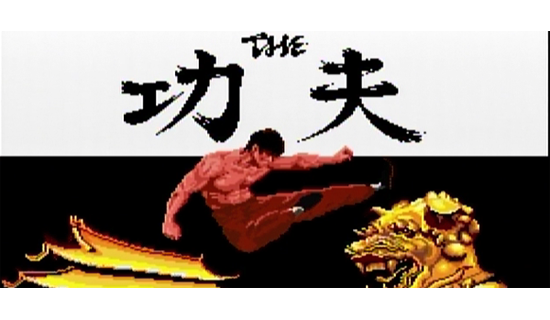Most of the beat-em-up games we’ve seen so far has been arcade ports (with the exception of the first three Hokuto no Ken games). The Kung Fu was obviously meant to be an arcade game in spirit, with Spartan X’s DNA flowing strongly through it. The PC Engine was marketed as the next evolution of current consoles after all, so it needed something to set a fairly standard game like this apart from its contemporaries on the Famicom/NES and Mark III/Master System. That something would be giant character sprites, standing nearly the entire height of the screen.
The story is about as standard as it gets: An assassin by the name of Wang (who looks remarkably like Bruce Lee) sets out to defeat the Dark Emperor and save the country that he has overtaken. To do this he must of course use his own kung fu to defeat other martial artists, and eventually the Dark Emperor himself (who turns out to be nothing more than a stereotypical practitioner of drunken kung fu). There are four stages (along with a bonus stage in which you stop a cursor on a power gauge in order to break a large pot), each divided into 3 separate parts that contain a boss at the end. You get three lives and up to two health meters to make your way through these stages, though it is possible to earn more through score and oolong tea power-ups (in the case of health).
Due to the amount of data taken up by the character sprites, the moves that Wang can perform are rather basic: Standing and crouching punches, as well as standing and jumping kicks (both straight up in the air or jumping forward). There are also a couple of punch-based special moves that can only be activated after you’ve taken two or three hits from a boss. The manual contains no mention of these, and they seem to come out randomly even after you’ve already taken the requisite number of hits. There’s only one type of regular enemy, with variations introduced through pallet swaps and slight behavior changes. They have no real attack animations, so they really just run into you before disappearing. Including the final boss, there are 5 different boss sprites that also get pallet swaps and minimal behavior changes throughout the game. A few of them are even swaps of Wang himself! They do all have move animations though, and are far more challenging than the bosses of Spartan X. You can’t get away with mashing buttons and expect to not be destroyed, so you shouldn’t be ashamed to consult a FAQ since good number of the bosses have specific attacks that they’re weak to. Some of the later bosses aren’t quite as exploitable though, which is why it’s also important to be aware of the special moves. Even so, it feels like those later bosses guard and counterattack on every single hit one attempt, and maybe let you beat the hell out of them on a subsequent one.
The real challenge lies in the (mostly) inanimate objects that are frequently thrown at you from off-screen though: Rocks, sticks, snakes, knives, strange green balls, shattering plates, fans, blue flames, axes, staffs, bats, and a giant boulder. The amount of them that are thrown at you might seem ridiculous (especially in later levels), but like other action games of this time it’s just a matter of memorizing the patterns. There’s nothing random about the way anything comes at you.
When the PC Engine was probably the highest performing and most impressive piece of game console hardware in 1987, this game probably was impressive despite its simplicity (it wasn’t actually available at the launch of the PC Engine, but less than a month later). After all, Spartan X wasn’t a particularly complex title either. But whereas Spartan X felt like just the right length for the simplicity of the game, The Kung Fu feels a little too padded out with its many pallet swaps, higher number of levels, and excessive reliance on off-screen objects to wear down player health. It just isn’t as fun as Spartan X, and lacks any sort of charm. History also supports this viewpoint, since beat-em-ups featuring giant sprites never really frequently repeated. And since the US release came a full two years later, there was already worthy beat-em-up competition appearing on the Sega Genesis.
Apart from the PC Engine HuCard itself, this title was released by Hudson in all regions on the Wii Virtual Console, as a Game Archives/PC Engine Classic on the Playstation Store (for play on the PS3, PSP and Vita), as well as on iOS via the TurboGrafx-16GameBox. Konami acquired Hudson in 2012, but still saw fit to release this title on the 3DS and Wii U Virtual Consoles, but only in Japan. They also released it on a few different cloud gaming services that exist only in Japan.




